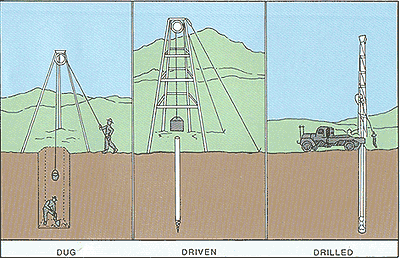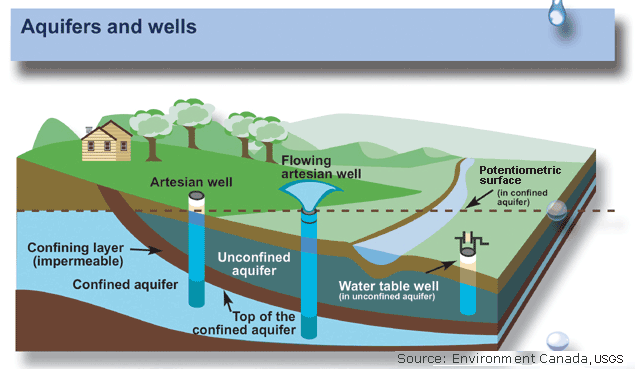There’s a good chance that the average Joe who had to dig a well in ancient Egypt probably did the work with his hands, a shovel, and a bucket. He would have kept digging until he reached the water table and water filled the bottom of the hole. Some wells are still dug by hand today, but more modern methods are available. It’s still a dirty job, though!
Wells are extremely important to all societies. In many places wells provide a reliable and ample supply of water for home uses, irrigation, and industries. Where surface water is scarce, such as in deserts, people couldn’t survive and thrive without groundwater.
Types of Wells
Digging a well by hand is becoming outdated today (would YOU want to do it?). Modern wells are more often drilled by a truck-mounted drill rig. Still, there are many ways to put in a well—here are some of the common methods.
Dug Wells

Figure 1. Well Types
Hacking at the ground with a pick and shovel is one way to dig a well. If the ground is soft and the water table is shallow, then dug wells can work. Historically, dug wells were excavated by hand shovel to below the water table until incoming water exceeded the digger’s bailing rate . The well was lined with stones, brick, tile, or other material to prevent collapse, and was covered with a cap of wood, stone, or concrete. They cannot be dug much deeper than the water table — just as you cannot dig a hole very deep when you are at the beach… it keeps filling up with water!
Driven Wells
Driven wells are still common today. They are built by driving a small-diameter pipe into soft earth, such as sand or gravel. A screen is usually attached to the bottom of the pipe to filter out sand and other particles. Problems? They can only tap shallow water, and because the source of the water is so close to the surface, contamination from surface pollutants can occur.
Drilled Wells
Most modern wells are drilled, which requires a fairly complicated and expensive drill rig. Drill rigs are often mounted on big trucks. They use rotary drill bits that chew away at the rock, percussion bits that smash the rock, or, if the ground is soft,large auger bits. Drilled wells can be drilled more than 1,000 feet deep. Often a pump is placed at the bottom to push water up to the surface.
Water Levels in Wells
Ground-water users would find life easier if the water level in the aquifer that supplied their well always stayed the same. Seasonal variations in rainfall and the occasional drought affect the “height” of the underground water level. If a well is pumped at a faster rate than the aquifer around it is recharged by precipitation or other underground flow, then water levels around the well can be lowered. The water level in a well can also be lowered if other wells near it are withdrawing too much water. When water levels drop below the levels of the pump intakes, then wells will begin to pump air—they will “go dry.”

Figure 2. Aquifers and Wells
Contribute!
Candela Citations
- Groundwater: Wells. Authored by: Roger M. Waller. Provided by: USGS. Located at: http://water.usgs.gov/edu/earthgwwells.html. Project: Ground Water and the Rural Homeowner. License: Public Domain: No Known Copyright
